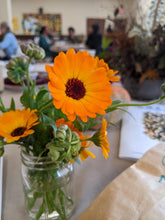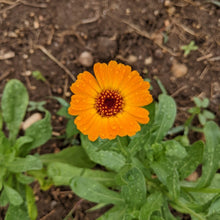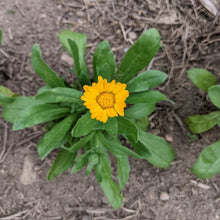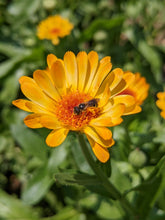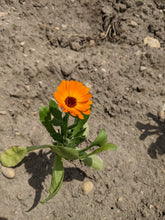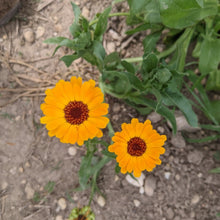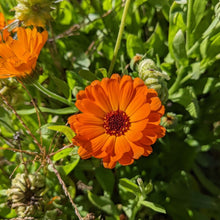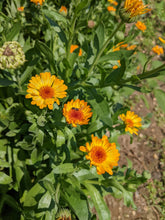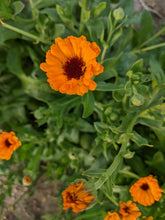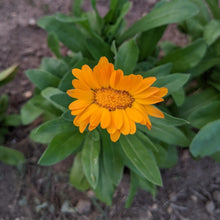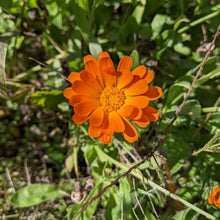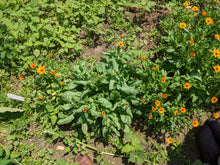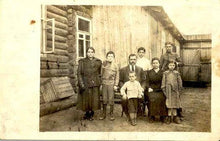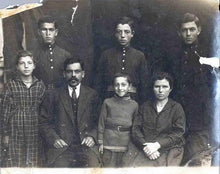'Odesa Market' Calendula
Regular price
$4.25
Sale
Calendula officinalis
Origin: Ukraine
Improvement status: Landrace
Seeds per packet: ~25
Germination tested 1/2024: 90%
Life cycle: Annual or short-lived perennial (in mild climates)
This diverse landrace calendula was collected in June 1986 at the Odesa farmer's market in Ukraine by Kate Rogers Gessert of Eugene, Oregon, who recorded it at the time as a "local type." She donated the variety to the USDA the following year, and they've maintained it since at the North Central Plant Introduction Station in Ames, Iowa. Due to my [Nate's] family history in Ukraine, and Odesa specifically — my great-grandparents fled anti-Jewish violence there in 1905 — I requested a small sample of the seeds in mid-February 2022, along with a number of other Ukrainian seeds. As it turns out, Russia would launch its ignominious invasion of Ukraine eight days later on February 24th.
In growing these seeds out, I had expected to feel nothing but enjoyment and a renewed connection to my ancestors — and I certainly did feel those things. But ultimately it became a much more bittersweet experience, not only because the beautiful calendula was such an incongruous reminder of the ongoing war — but also because the vibrant flowers proved to be a much more potent reminder of my own family's generational trauma than I ever expected.
If you care to read about that trauma, along with the requisite history lesson, please read on...
(Every year I seem to write one excessively long seed description. This year it's this one.)
***
It was probably sometime in the spring of 1905 — based on everything I've been able to piece together — that my great-grandparents made the decision to leave Odesa, Ukraine, and reach for a new life free from the discrimination and violence that they increasingly feared would ruin or even take their lives.
Mary Zaitsev was a dressmaker. She was a hard worker who ran her own dress shop and traveled regularly to Vienna to purchase the exquisite laces, velvets and other fabrics that made her dresses so fine. One day she found herself strolling down a street in Odesa (at the time a single woman well into her 30s), when she noticed the expert needlework on some buttonholes in the shop window of a tailor named Israel Choskovitch. She decided she just had to go inside and admire them to the proprietor. At least that's the charming story they told their children and grandchildren — though it's occurred to me more recently that it's just as likely that Mary was simply looking for a pretext to introduce herself to Israel, and she found one in his buttonholes. Regardless, they proved to be a love match.
As I understand it, Israel soon hitched his proverbial wagon to his entrepreneurial new wife and began working in her dress shop. As I think more about it, I suppose it's possible this was her plan all along — maybe even from the moment she saw those perfect buttonholes!
Odessa had long been a destination for Jews from across the "Pale of Settlement" (regions in the former Russian empire in which Jews were allowed to settle) and beyond. Even before the city's modern founding in 1795 — before which it was a Slavic port-settlement as early as the 1400s, under the name Kotsiubijiv and the authority of the Grand Duchy of Lithuania — Jews played a major role in the cultural and economic life of the city. In the 1600s, we served widely as merchants and translators among the Cossacks of the Zaporozhian Sich (a semi-autonomous polity that existed between the 1500s and 1700s), and also as importers of goods to the mainland, in particular from neighboring Crimea, an important area of agricultural production (still then in the hands of the Tatar people through the Crimean Khanate). One reason Jews frequently worked as importer/exporters is that the Hebrew language — at the time still mainly a liturgical language — was used as a lingua franca between Jews from various different communities who otherwise would not have been able to communicate (given their first languages were as diverse as Yiddish, Ladino, Russian, Polish, Lithuanian, Judeo-Arabic, Judeo-Persian, Judaeo-Aramaic, Judaeo-Tat, Judaeo-Georgian, Azerbaijani, Crimean Tatar, Turkish, Bukharian, and even Judaeo-Malayalam, spoken by Malabar Jews in India). The Hebrew language was like a superpower, enabling Jews to communicate across myriad international cultural divides in a way their local neighbors never could. In Odesa, at the beginning of the 1800s, the small Jewish community — just a few hundred people — largely controlled the trades in silk, cotton, wool, hardware, iron, shoes, and salt. Over the next century, Jews flocked to the shining cosmopolitan city seeking opportunity, culture, and adventure. By 1900, despite various Tsarist restrictions on Jewish life, there were well over 100,000 Jews living in Odesa, comprising over a third of the population.
We don't know much at all about Mary or Israel's origins. Apparently "Mary Zaitsev" was not a traditionally Jewish name, so there's always been a suspicion in the family that she was not Jewish before she married Israel. But Israel clearly was Jewish, and perhaps with Polish roots (in America he usually wrote on US Census forms that his nationality was Russian, but once he declared himself Polish). Nevertheless, upon their marriage and for the rest of their lives they lived as a Jewish couple. And all was well enough for the young-middle-aged pair, as far as we know, at least until the failed Russian revolution of 1905 which began in January of that year.
Already the situation for Jews in Odesa had been intermittently very dangerous. A series of pogroms (organized episodes of mass violence directed against Jews) began in Odesa in 1821, initially rooted in conflict between ethnic Greeks and Jews in the city (which had long been far more open to immigrants than other cities in the Russian Empire). But while the early violence against Jews came from the Greek community, more and more Russian and Ukrainian people took part in subsequent pogroms (in 1859, 1871, 1881, 1886, and 1900). When the worst anti-Jewish violence up to that point culminated in four days of calculated destruction in October 1905 which killed up to a thousand Jewish citizens of Odesa, the violence was conducted with the complicity of local authorities, if not at their direction. It's unclear if my great-grandparents had seen the writing on the wall and were safely away from Odesa by that point, or if they were there to witness the disaster.
The anti-Semites in power across the region didn't need a new reason to target my ancestors, as there was a long tradition of scapegoating Jews across Europe, but since the failed 1905 revolution (which was ongoing and thus not yet failed for most of 1905) had many Jewish labor organizers and communists among its vanguard, the backlash against all Jews was swift and violent — and not at all limited to Odessa (indeed, at least half of my great-grandparents and one set of great-great-grandparents all fled different parts of Europe for America in 1905).
The details here are sketchy, but it seems that at some point in 1905 as revolutionary fervor swept the city, one of Mary's employees disappeared and a search of their work-station revealed a gun. Whether they believed that worker had put them at risk, or they simply saw the gun as a sign that things were escalating dangerously, it was the straw that broke the camel's back and finally pushed the couple to leave. Somehow Mary managed to line up a job in Buffalo, New York, and so they soon left their whole world behind to seek a new life. We don't know exactly when they left or how their emigration proceeded, but we know that Mary was pregnant when they arrived, that their name was changed from Choskovitch to Toskov, and that on June 21st, 1906, Mary gave birth at the age of 40 to a baby girl who would grow up to be my grandma Helen. Tellingly, when they'd finally arrived in Buffalo, Mary was visibly pregnant and so was fired on the spot from her job, but records indicate that by seven years later she was running her own dress shop at 848 Main Street in Buffalo, with nine women and three teenagers working for her. Grandma Helen described her early days as so terribly boring, with her parents working all the time, that she ran away to kindergarten at the age of 4. (Always precocious and a good student, she went on to Cornell University as an undergraduate and then graduated from the University of Buffalo's medical school as the only woman in her class in the early 1930s.)
***
Much of the history above I only fully pieced together over the past year. The experience of growing the calendula (along with Odesan varieties of nigella and welsh onion) pushed me to do more research, and not only on my ancestors from Odesa. My mother's other set of grandparents left Belarus in 1905 as well, and I realized I knew hardly anything about their lives. All I knew was that their names were Molly Klebanoff and Adolf Wolfson (a very unfortunate name for a Jew). As it turns out, I didn't even know that. When I asked my aunt Ellen, my late mother's eldest sister, she told me that his name in the "old country" was really Elia — she would know because she's named after him — and he actually chose the name Adolf when he arrived. I soon found their Ellis Island records (despite a transcription error that had him listed as "Elic"), and learned from the passenger manifest that they arrived with $12.50 and stayed with a relative on Staten Island before moving on to Buffalo too (and the relative was named Adolf, so I suppose now we know how he came up with that name). Molly and Elia boarded a ship called the Finland in the port of Antwerp, Belgium, and crossed the ocean to their new lives.
If my mom ever told me the story of Molly and Elia's courtship and marriage, I must have blocked it out. But I suspect she never did. The buttonhole story on her mother's side was a much better story. According to Ellen, the young couple "met in the woods, were married that day by a rabbi, and then walked across Europe and got on a boat. They never loved each other. It was a marriage of necessity. She had a bit of money, and he was a man. His choice was between running or chopping off his trigger-finger in the hopes of avoiding being drafted into the Tsar's army. That was it." That was the story.
I haven't learned much more about them since then, but I've tried to imagine what it must have been like, the terror they must have felt to suddenly leave everything behind and just as suddenly to be bound so tightly together with a stranger. It's admittedly difficult for me to imagine, though recent years have primed me for such a thought-exercise.
Elia/Adolf never recovered from his early traumas. He was a skilled brick-layer (the Finland's manifest called him a "plaster-layer") and I know he lived long enough to help build some of the specialized chimneys for Buffalo's steel industry. But the one other thing I know about him is that he was an alcoholic — and not a pleasant one. The only anecdote about his life that was passed down to me is that one night he came home so late and so drunk that Molly refused to let him in. After he begged for something to eat, she came outside and served him a bowl of mop-water which he eagerly lapped up. He died in his mid-50s.
Molly, on the other hand, was the one grandparent with whom my mom Barbara and her sisters Ellen and Wini had a long relationship. She lived well into her 80s, known to them as "Bubu" (no doubt because an early grandchild must have had trouble pronouncing "bubbe", the Yiddish word for grandmother). She spoke English with a thick Russian accent and was everpresent in their lives, along with her other two grandchildren (she had three kids: my grandfather Irving, the eldest who had three girls, along with Annie, who had one son, my late cousin Bobby, and Rose, who had one daughter, my full-of-life cousin Elaine, the only one who still lives in Buffalo).
My mother used to do an impression of her Bubu. The two I remember most were both lists. The first was when she finally went to take her citizenship exam in probably the 1950s. She was asked if she knew who the current President was, and then the previous President, and she proceeded to list — in order — all of the men who'd served as President since she arrived half-a-century earlier! In the other story, Bubu would try to recount all of her siblings names with her thick Russian accent: "Dehr vos Malke, oond Golda, oond Leah, oond Dovid, oond Perla, oond Zalman..." and the punchline was always that sometimes there were 8 names, sometimes 10, sometimes 12. "Who remembers? It vos so long ago." My ever-cheerful mother always played it for laughs. But this year — thanks to the diligent research of a third-cousin named Mark whom I've never met — I finally learned some of the tragic truths about that list of long-lost siblings, painful truths that Bubu likely never knew: that her littlest brother Zalman (who made it to Azerbaijan just before World War I) died as an old man in a Soviet gulag, and that her sisters Leah and Perla, along with many of her nieces and nephews, were murdered by the Nazis in 1941.
***
There's actually a monument to the murdered Jews of Bobr, Belarus, the shtetl (small Jewish village) where the Klebanoffs lived. It's a small obelisk, probably 4 feet tall, surrounded by a low fence on a patch of grass between a road and some woods. I found pictures online. It was erected in 1959 and the inscription in Russian reads, "In memory of the victims of fascism. Here are buried 961 innocent Soviet civilians of the urban settlement of Bobr who were brutally shot to death on October 10, 1941." Of course, they weren't just "Soviet civilians": they were Jews. And I've read that not all of them were shot. Some were burned alive in their own homes.
Molly's sister Golda somehow managed to survive the war, but she died in 1956 and we still don't know much about her children and if they survived. As far as we can tell, that monument is all that's left of my family in Bobr — other than a few musty skeletons buried in those woods.
On both sides of my family, the younger generations here in America were never taught the Yiddish or Russian languages. They weren't told the full harrowing stories of life and death in Europe. All of that was in the past — and the grandparents insisted on keeping it there. Buried deep.
My mother Barbara, who went on to become a doctor like her mother before her, had been a Russian major in college. Recently, I've begun to regret never asking her why she chose Russian — besides her love of Dostoevsky. I wonder now if she wasn't trying to connect with her own history too; if she didn't mourn the loss of all the people and communities she never knew; if she felt, as I do, the profound loss of culture and history that was the inevitable result of immigration and assimilation under the shadow of genocide.
***
My year of looking backward hasn't only been grim revelations though: Zalman had descendants who survived the Soviet years, and some of them now live in San Diego! I learned that fully six of the Klebanoff siblings made it to the US before the Holocaust, and that I have cousins all over the place. I also learned the names of Bubu's parents and even her grandparents, and that her father Berko, in 1887, claimed — on a document that still exists — losses in a fire: "Berko, son of Yankel Klebanov, lives on Tolochinskaya Street. Loss: wooden addition to the house burned completely, wagon and agricultural tools were lost in fire as well. Estimated damage: 80 rubles. House was not insured." My great-great-grandfather Berko! My first verifiable farmer ancestor!
I suppose everything comes full circle eventually.
Most amazingly, just a few weeks ago, third-cousin Mark let me know that he had made contact with one of Zalman's descendants who actually had photos from Bobr, including the two posted above. My great-great-aunt Leah is in the lighter photo, seated at right among her family. Her sister Perla is in the darker photo, also seated at right among her family.
Just a few months after learning for the first time the actual names of relatives who perished in the Holocaust, suddenly I was staring them right in the face. The experience was chilling and surreal, but also quite beautiful.
And now, in telling their story, in saying their names, I feel like I somehow have the unlikely opportunity to finally give rightful honor to their memory.
Full circle indeed.
***
So while this humble calendula may be connected to the happier side of the family (and of course I have no idea if my Odesa forebears ever used this plant or even knew of it), it will forevermore be connected in my mind and my heart with so many of the people who came before me, known and unknown.
'Odesa Market' calendula's subtle diversity actually reminds me of a family: each plant so similar to the next, yet still with those small but clear differences that mark each one as an individual.
I will forever appreciate this little family of plants for pushing me to explore as much as I can of my own family and our collective history — even the parts that my ancestors struggled so hard to forget.
Nathan Isaac Kleinman - 1/12/23















